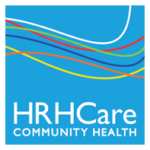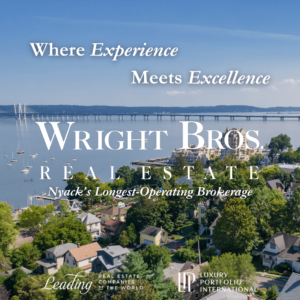The Barons of Broadway: River Hook Farm
by Mike Hays

River Hook Farm estate house facing east toward Broadway. This is the “rear” of the house with a porch and patio.
Of all the barons who flocked to build homes on Upper Nyack farms beginning in the Gilded Age, the last to arrive was also the most local. In 1934, William P. Haring, Jr., a native of Piermont, bought a 31.4-acre strip of land extending from Broadway to above 9W. The estate was once a part of John L. Smith’s farm, one of the five farms in Upper Nyack at the time of the Revolutionary War. Haring built a house on the property known as River Hook Farm (and then as Sheep Farm) by nearby residents in the late 20th century.
William Post Haring, Jr., financier
The Harings are an old Rockland County family, as are the Onderdonks. William P. Haring, Jr., born on September 5, 1896, was raised in the 1737 stone Onderdonk house on Piermont Ave, one of the oldest houses in Rockland County, which had been in his grandmother’s family. He graduated as class valedictorian at the Tappan Zee High School in 1913.

1983 photo showing a Revolutionary War pageant at the Onderdonk house in Piermont. The house is much changed today.
Haring immediately went to work at 55 Wall Street for the National City Bank with the financiers Percy Pyne and Henry R. Taylor. The Taylor family was extremely rich, owning a free-standing mansion at #3 E. 71st Street. Haring must have been a trusted insider to the banker since he took over management of Henry Taylor’s estate upon his death in 1925.
Haring seems to have escaped the market crash. By 1935, he was a partner of another old Wall Street brokerage company, Lawrence Turnure & Co. He continued to work on Wall Street until his death in 1958. He was also a director of the Suffern Bank and Trust Company before it merged with the Rockland National Bank. He was also director of the Cox and Stephens Aircraft Corp. and a member of the Bankers Club in New York City.
William Haring, Politician
In 1931, Haring ran for mayor of Piermont as what the Rockland County Journal called “a Republican running as a Democrat… and a man of independent means who was said to have spent plenty of ‘dough’ on himself.” In fact, Haring was a lifelong Republican, later serving in many different roles for the Rockland County Republican Committee, including Treasurer and as a delegate to the New York State Republican convention. After moving to Upper Nyack, he served as a trustee and deputy mayor of Upper Nyack from 1936 to 1950. In addition to his time in politics, Haring was a major benefactor to the Nyack Hospital.
The Harings move to Upper Nyack

1876 map detail of Upper Nyack. The E. H. Owens farm is in the center with the lane leading to the house as it is today. Midland and Broadway are the two horizontal streets.
Haring married Dorothy Folsom in the Onderdonk House in Piermont, and they continued to live there until 1934 when they purchased property in Upper Nyack (626 N. Broadaway). Hester Clark Haring, their only child, was born in 1931, perhaps serving as the catalyst to the family to build a new home in Upper Nyack.
An 1876 map of the farm, then owned by E. H. Owens, shows three buildings on the property and an S-shaped road through the property that is still in use today. A survey done when Haring acquired the property shows these buildings. The placement of the estate house is penciled-in on the survey where the existing farmhouse was sited. New York architect Julius Gregory, noted for his work in House and Garden and House Beautiful magazines, designed the house.

1934 property survey between Broadway and Midland. Penciled in over the old house is the new location of River Hook. The cottage is penciled in near Midland. Note that Locust Drive, Kuyper, Lewis, and Hook Mountain do not appear. They were built during the post-1960s building boom.
The Estate
The Haring house is a long, 16-room brick two-story house of approximately 4,000 sq. ft., with two large bookend chimneys set on the crest of a hill above Broadway. What appears to be the front of the building visible from Broadway is in fact the rear of the house. The remains of a patio are visible on this side of the house. The three-bay garage faces Broadway and is mostly hidden from view by a brick-walled courtyard. The front of the house faces west looking up a sloping meadow. An old circular driveway is still visible in front of the house.
Stories have it that Hester’s nursery at the rear of the second floor had bars on the window for many years, a result of fears brought about by the news of the Lindbergh kidnapping of 1932 (the Lindbergh baby had been kidnapped from his second story bedroom with the use of a ladder). The Harings built a Cape Cod colonial cottage along Midland Ave using the same style of brick featuring a unique brick concave chimney cap. Several older buildings were retained by the Harings, including a three-story 1906 carriage house made out of native field stones that featured high gables and old-style, ornate windows. All of these buildings may be found today in Upper Nyack’s River Hook Preserve
The name River Hook Farm may predate the Harings. River Hook is first mentioned in newspapers in 1937 when the Harings hosted a wedding reception for a cousin at River Hook Farm. The estate house was well-known in the Nyacks. It was the location of many community meetings including the Garden Club and meetings of the county fair group to decide on exhibits to send to the World’s Fair in 1939. One of the items to be displayed was a British cannonball owned by Haring that was dug out of the yard of the old Onderdonk property in Piermont where it had been fired by the British in 1777. William Haring died at age 60 in 1958. Dorothy died a year later in 1959.
The Cason family at River Hook
Hester Haring Cason inherited the family estate along with the Onderdonk house and property in Piermont. Hester was a bright young woman who went on to graduate from Bennington College in 1962, completing a six-week study tour in Europe after graduation.
Also in 1962, Hester sold a nearly 20-acre parcel of land north of Midland Avenue to developers for $34,790. The land was to become the houses on Kuyper Ave.
Hester worked for Lamont Doherty, and in 1965 met James Cason, who had grown up in Oregon and moved to Nyack in 1963. They began raising sheep at River Hook Farm. Cason liked the sheep since they cropped the two meadows he was tired of mowing. Eventually, the sheep were moved from behind the house to the large meadow facing Broadway. The Casons did not sell or butcher their sheep.

A view of the front meadow facing Broadway just to the north of the estate house.
Even the neighbors approved. “It makes it look kind of rural, “said Geraldine Goumas who lived on Locust Drive. The sheep migrated out front after they ate nearly all the grass in a fenced-in section behind the house, which led to the neighbor’s calling the farm, the Sheep Farm. Cason, an electric engineer in New City at the time, erected the front yard fence himself and gave away the wool they produced.

View of the west meadow with the estate house in the background. This is the front of the house facing west.
In 1993, James Cason ran and won the first of two terms as Trustee of Upper Nyack, running as a Republican on the Riverhook Farm Party. While running for office in 1993, he said that he was a believer in “giving back to the community the same way I am restoring a brownstone in New York City. I want people to live here quietly without high rises and cluster housing.”
In 2006, the vacant and dilapidated Onderdonk house and other Piermont properties were sold. As the Casons aged, so did the farm. In 2011, Hester died and farming at River Hook was a thing of the past.
River Hook: The Hester Haring Cason Preserve

The carriage house from 1904 will be a feature of the new preserve.
In 2018, the Village of Upper Nyack acquired the remaining 12 acres as a greenspace from the 95-year-old James Cason for $2.4M. As a covenant of the deed, the property was to contain the name of Hester Haring Cason. Since the acquisition, the preserve has been remediated and opened in late October 2019 as a passive nature preserve for walking and biking. Mayor Karen Tarapata continues to involve Upper Nyack residents in determining a future vision and course of the last open space in Upper Nyack.
See also:
Photos by Mike Hays.
Michael Hays is a 30-year resident of the Nyacks. Hays grew up the son of a professor and nurse in Champaign, Illinois. He has recently retired from a long career in educational publishing with Prentice-Hall and McGraw-Hill. Hays is an avid cyclist, amateur historian and photographer, gardener, and dog walker. He has enjoyed more years than he cares to count with his beautiful companion, Bernie Richey. You can follow him on Instagram as UpperNyackMike.

 Nyack People & Places, a weekly series that features photos and profiles of citizens and scenes near Nyack, NY, is brought to you by HRHCare and Weld Realty.
Nyack People & Places, a weekly series that features photos and profiles of citizens and scenes near Nyack, NY, is brought to you by HRHCare and Weld Realty.







